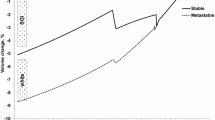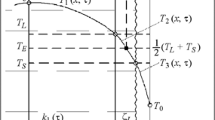Abstract
Working with liquid metal makes the casting method very advantageous, but also presents some difficulties. One of the common challenges in the casting process is that the liquid metal may not fill the mold cavity completely. This is mainly due to the contact of the liquid metal with the mold surface in the mold cavity, the high heat transfer coefficient of the mold material, and the undercooling and solidification of the liquid metal during liquid movements. For this reason, the fluidity of the liquid metal is important for robust casting production. The fluidity is affected by many factors such as mold properties, casting temperature, and alloying elements. In this study, it is aimed to investigate the fluidity characteristics of GGG60 alloy. For this purpose, the effects of casting temperature, different inoculants, and different inoculant quantities were used in the new mold design, which has different cross-sectional thicknesses. The distance of the alloy in the cavities was also compared with FlowCast Casting simulation software.









Similar content being viewed by others
References
ASM International Handbook Committee, ASM Volume 15 Casting. ASM International, Ohio (1988).
Theuwissen K, Lacaze J, and Laffont L, Carbon 96 (2016) 1120, ISSN 0008-6223.
Gouveia R M, Silva F J G, Paiva O C, Andrade M F, Silva L, Moselli P C, and Papis K J M, Metals 7 (2017) 382.
Campbell J, Castings, Butterworth, Heinemann (2003).
Kharkiv, Physical and Chemical Bases Technological Processes (2013). Retrieved from https://cidecs.net/wp-content/uploads/2019/01/Lecture-instructions-in-Technology-of-Enginearing-in-III-Parts.pdf.
Vignesh R, Gandhi M S, Vignesh A, and Rajarajan P, Int J Adv Technol 7 (2016) 157.
LianJiang Metals Company, Re: Fluidity of Cast Iron and Its Test Methods [Online forum comment] (2019). Retrieved from https://kitairu.net/minerals-and-metallurgy/metals-and-metal-products/metal-products/cast-and-forged/796727.html.
Sabatino M D, and Arnberg L, Metall Sci Technol 22 (2013).
Saxena S, and Sharma P K, Int J Innov Res Sci 6/2 (2017).
Seıdu S O, and Rıpoşan I, UPB Sci Bull Ser B 3/2 (2011), ISSN 1454-2331.
Koch M, and Soulas K, Inoculatıon of Grey and Ductıle Iron. 7th International Ankiros Casting Congress, September 12–13, Istanbul, Turkey (2014).
Karadeniz E, Çolak M, and Barutçu F, Ömer Halisdemir Üniversitesi Mühendislik Bilimleri Dergisi 6 (2017) 275.
Aslandoğan R, Dökümde Akıcılık ve Akıcılığı Etkileyen Faktörlerin Araştırılması (Yüksek Lisans Tezi), Yükseköğretim Kurulu Ulusal Tez Merkezi’nden edinilmiştir (Tez No. 244055) (2009).
Han Q, and Xu H, Scr Mater 53 (2005) 7.
Haque M M, J Mater Process Technol 191 (2007) 360.
Yang L, Li W, Du J, Wang K, and Tang P, Thermochim Acta 645 (2016) 7, https://doi.org/10.1016/j.tca.2016.10.013.
Çolak M, Kayikci R, and Dispinar D, Trans Indian Inst Met 68 (2014) 275.
Çolak M, Arslan İ, and Gavgalı E, Eng Sci (NWSAENS) 13 (2018) 280.
Erturk S O, Kumruoglu L C, and Ozel A, Acta Phys Pol Ser A 131 (2017) 370.
Kayıkcı R, and Nergiz M, Besleyicisiz Döküm Yöntemi İle Dökülen Bir Küresel Grafitli Dökme Demir Dökümün İncelenmesi. 3. Uluslararası Döküm ve Çevre Sempozyumu (IFES2009), İstanbul (2010).
Svensson I L, Component Casting with Simulation, Jönköping University, Jönkoping (2002), p 1.
Stefanescu D M, Mater Sci Eng A 413 (2005) 322.
Schmidt D C, The Basics of Solidification, Gating and Risering of Cast Irons, AFS Wisconsin Regional Conference, Finite Solutions Inc, Slinger WI (2007).
Meredith J F, Solving Porosity Problems in Graphitic Iron Castings, Casting Solutions Pty Ltd, Moorebank (2008).
Teke Ç, Çolak M, Tas M, and Ipek M, Acta Phys Pol A 135 (2019) 1105, https://doi.org/10.12693/aphyspola.135.1105.
Kayikci R, Çolak M, Sirin S, Kocaman E, and Akar N, Mater Technol 49 (2015) 797, https://doi.org/10.17222/mit.2014.266.
Teke Ç, Çolak M, Kiraz A, and Ipek M, Sci Iran (2019), https://doi.org/10.24200/sci.2019.50819.1881.
Author information
Authors and Affiliations
Corresponding author
Additional information
Publisher's Note
Springer Nature remains neutral with regard to jurisdictional claims in published maps and institutional affiliations.
Rights and permissions
About this article
Cite this article
Çolak, M., Kaya, S. Investigation of the Effect of Inoculant and Casting Temperature on Fluidity Properties in the Production of Spheroidal Graphite Cast Iron. Trans Indian Inst Met 74, 205–214 (2021). https://doi.org/10.1007/s12666-020-02159-5
Received:
Accepted:
Published:
Issue Date:
DOI: https://doi.org/10.1007/s12666-020-02159-5




